MDC III NUR2502 ALL FINAL EXAM 2023 QUESTIONS AND ANSWERS (LATEST UPDATE)
Document Content and Description Below
1. Which is not an early sign of left sided heart failure? a. Nocturnal cough b. Edema c. Fatigue d. Feeling of heaviness in arms/ legs 2. Which is not a valid treatment option for sickle cell cr... isis? a. Blood transfusion b. Provide a warm environment c. Prepare the patient for surgery d. IV fluids and pain management 3. Which is NOT a treatment for heart failure? a. diuretics b. antibiotics c. heart transplant d. beta-blocker 4. Essential care & education following mechanical valve replacement includes all BUT: a. anticoagulation therapy for life b. get prophylactic antibiotics for dental work c. monitor for bleeding d. use straight razor 5. Which organ is affected the most in hemochromatosis? a. heart b. lungs c. liver d. kidneys 6. Which is NOT a sign/symptom of leukemia? a. weight gain b. easy bruising c. elevated WBC d. hematuria 7. Which patient is NOT at high risk for infective endocarditis? a. recent valve replacement AND dental work b. IV drug abuser c. recent heart surgery d. immunocompromised individual 8. Which is NOT a diagnostic sign for pericarditis? a. ST elevation in all leads b. pericardial friction rub c. pericardial chest pain d. fever and signs of left sided heart failure 9. A deficiency in the number of red blood cells is called: a. anemia b. polycythemia c. hemophilia d. thrombosis 10. Echocardiogram is used as a diagnostic tool for all BUT which disease? a. hypertension b. heart failure c. pericarditis d. valvular heart disease 11. Which lab test is most likely elevated in hemophilia? a. Prothrombin time b. Creatinine c. Leukocytes d. Activated partial thromboplastin time 12. Why would a patient have a pericardiocentesis? a. for pericardial effusions b. for cardiac tamponade c. for pleural effusions d. for ascites 13. Which is NOT a sign/symptom of dilated cardiomyopathy? a. Echo shows ventricular hypertrophy b. weakness c. Echo shows dilated ventricles d. Palpitations 14. The medical term for platelet is: a. erythrocyte b. leukocyte c. phagocyte d. thrombocyte 15. Which is NOT a recommendation for hypertension? a. increase sodium intake b. exercise 3-4 times per week c. lose weight d. adhere to medication regime prescribed 16. Which is NOT a treatment in PAD? a. antiplatelet medication b. wear insulated shoes c. cross legs when sitting d. dependent positioning 17. Which is included in education for polycythemia vera? a. wear support hose during the day b. drink 3L of fluid daily c. elevate feet when seated d. exercise as much as you want 18. What should be avoided in patients with thrombocytopenia? a. rectal trauma, including enemas b. oral trauma, flossing c. contact sports d. electric shaver 19. Which is an early sign of multiple myeloma? a. easy bruising b. hypertension c. bone fractures d. infection 20. Signs and symptoms of lymphoma include all BUT: a. fevers b. night sweats c. enlarged lymph nodes d. syncope 21. What is the priority action when a reaction to an infusion is suspected? a. check the vitals b. reposition the patient c. stop the infusion d. assess the lung sounds 22. Which is NOT a treatment for SVT? a. glucose administration b. adenosine c. vagal maneuvers d. synchronized cardioversion 23. Which lab value is out of range? a. Hemoglobin - 15.0 mg/dL b. platelets 200,000 mm3 c. white cell count 8,000 mm3 d. prothrombin time of 26 seconds 24. What is NOT a sign or symptom associate with hemophilia? a. hypertension b. abnormal or excessive bleeding c. joint and muscle hemorrhages d. joint and muscle pain 25. Which sounds is indicative of mitral regurgitation? a. high-pitched holosystolic murmur b. rumbling, apical diastolic murmur c. blowing, decrescendo diastolic murmur d. systolic click 26. Which sounds is indicative of mitral valve prolapse? a. high-pitched holosystolic murmur b. rumbling, apical diastolic murmur c. blowing, decrescendo diastolic murmur d. systolic click 27. Which sounds is indicative of aortic regurgitation? a. high-pitched holosystolic murmur b. rumbling, apical diastolic murmur c. blowing, decrescendo diastolic murmur d. systolic click 28. Which post-anesthetic care patient should be seen / assessed first? a. A patient with respiratory depression b. A patient with decreased blood pressure c. A patient complaining of pain d. An alert patient ready for transfer to the floor 29. The nurse is preparing for initial rounds. Which patient should the nurse assess first? a. A client with diabetes with a glucose of 180 b. A teenager scheduled for PT this morning c. A 78 year old with a pressure dressing needing changing d. a 35 year old with copious secretions from his tracheostomy 1. Signs and Symptoms of Left sided Heart Failure (SATA) a. Pulmonary Edema b. Coughing c. Crackles d. Dependent Edema 2. How often should a patient with heart failure weigh themselves? a. Weekly b. Monthly c. Daily d. Hourly 3. What blood test is used to detect heart failure? a. Triponins b. CBC c. BNP d. ABGs 4. What diagnostic test is the gold standard to determine if a patient has heart failure? a. ECHO b. MRI c. Chest Xray d. Ultrasound 5. What are some risk factors that can lead to heart failure? (SATA) a. Lifestyle b. Hypertension c. Smoking d. Diabetes 6. What can predispose a patient to mitral stenosis? a. Rheumatic Fever b. Age c. Connective tissue disorder d. Infective endocarditis 7. What is NOT as symptom of mitral valve stenosis? a. Fatigue b. Hypertension c. Dyspnea on exertion d. Pink frothy Sputum 8. How is mitral valve stenosis treated? (select 2) a. Valve replacement b. transcatheter valve therapy c. Heart transplant d. Percutaneous balloon valvuloplasty 9. What is the best treatment for a patient with end stage heart failure? a. Heart Transplant b. Beta Blockers c. Coronary Artery Bypass Graft d. Percutaneous balloon valvuloplasty 10. What is the cardinal sign for pulmonary edema? a. Frothy Sputum b. Dyspnea c. Wheezes d. Syncope on exertion 11. What kind of medication will a client who has had a valve replacement be on for life? a. Antiarrythmias b. clotting factors c. Antihypertensives d. Blood thinners 12. If a patient has an order for oxygen but is not receiving any, what should the nurse do? a. Give them o2 b. Check order and come back c. Ignore them d. See other patients 13. What are signs that a patient with pulmonary edema is doing better? Select 2 a. Decreased SOB b. Decreased swelling c. Increased fatigue d. increased crackles 14. What are signs and symptoms of mitral valve regurgitation? (SATA) a. Jugular Vein Distention b. Murmur c. Tachycardia d. Peripheral Edema 15. What disorder commonly has mitral valve prolapse? a. Marfan Syndrome b. Cushing’s c. Hashimoto’s d. Dwarfism 16. What kind of murmur do you hear with mitral valve prolapse? a. Midsystolic Click b. early diastolic c. Continuous murmur d. Presystolic 17. What should you tell the patient to do if you're auscultating lung sounds and hear crackles? a. Ask them to take a deep breath b. Ask them to stand up and relisten c. Ask them to cough d. Ask them to start talking 18. What are some signs and symptoms of aortic stenosis? (SATA) a. Chest Pain b. Systolic Crescendo-decrescendo murmur c. Shortness of breath d. Midsystolic click murmur 19. What test is going to help determine how the valves of the heart are working? a. Ultrasound b. Transesophageal echo c. Angiogram d. Chest xray 20. If a patient is prescribed anticoagulants, what should we teach them? a. Watch for bleeding b. Play contact sports c. Use a straight razor d. Excessive bruising is normal 21. Who is most at risk for endocarditis? a. Patients who have had dental work b. Patients who have received IV antibiotics c. Patients who have been hospitalized for extended periods of time d. Patients who are on blood thinners 22. What is a key sign of infective endocarditis? a. Janeway lesions b. Tachycardia c. Bradycardia d. Hypotension 23. What is NOT a symptom of infective endocarditis? a. Weight gain b. Fever c. Chest pain d. Nodes on hands and feet 24. What are the appropriate treatments for infective endocarditis? (select 2) a. Antibiotics b. Anticoagulants c. Antihypertensives d. Anti-inflammatories 25. When listening to a patient with suspected pericarditis, what would you expect to hear? a. Pericardial Friction rub b. presystolic murmur c. middiastolic click d. systolic crescendo-decrescendo murmur 26. If left untreated, what is a complication of pericarditis? a. Cardiac tamponade b. Stroke c. Paralysis d. Seizures 27. A patient has pericarditis, what pain relief method will NOT work? a. Opioids b. NSAIDS c. Changing patient position d. Aspirin 28. What is a cardinal sign of dilated cardiomyopathy? a. Left ventricular dilation b. Inability to exercise c. Weight Gain d. Swelling of the legs and feet 29. If other treatments for cardiomyopathy fail, what is the next step? a. Cardioversion b. Ablation c. Heart Transplant d. Stenting 30. Your patient just had a heart transplant, what are the symptoms of rejection? (SATA) a. Shortness of breath b. Fluid Gain c. Decreased Ejection fraction d. Hypertension 31. What should a nurse teach a patient with atherosclerosis? (SATA) a. Increase HDL intake b. Decrease LDL intake c. Eat more fresh fruits and vegetables d. Exercise as tolerated 32. What is a symptom of peripheral arterial disease? a. Intermittent Claudication b. Abdominal pain c. Hypertension d. Shortness of breath 33. What medication is used to treat PAD a. clopidogrel b. statins c. lisinopril d. digoxin 34. All of the following are appropriate nursing interventions for a patient with dysrhythmias except a. Monitor patients activity tolerance and schedule activity b. Assess for edema, capillary refill, and peripheral pulses c. Monitor and document pts response to antidysrhythmic meds d. Assess vitals every 8 hours 35. A patient with myelodysplastic syndrome and a platelet count of 7000 complains of a HA what is immediate action? a. Administer aspirin per PRN order b. Administer nonpharmacological intervention like a cool compress c. Notify the healthcare provider d. Administer acetaminophen per orders 36. When taking a patients blood pressure, what should we instruct them to do? a. Uncross their legs b. Move their arms c. Stand up d. Lay down flat 37. A patient has a CT scan and an abdominal aortic aneurysm is discovered, what step should be taken? a. Patient should be immediately prepared for surgery b. Patient should be given anticoagulants c. Nothing d. Schedule for surgery tomorrow 38. A patient is having a myocardial infarction, what acronym is used for pain relief? a. SASS b. FAST c. MONA d. PQRST 39. What is the IMMEDIATE treatment for a ST elevation myocardial infarction (STEMI) a. Percutaneous coronary Intervention b. Cardiac rehab c. Atherectomy d. Coronary artery bypass graft 40. What should not be given to patient with a history of hemorrhage? a. Blood clot buster b. Tranexamic Acid c. aprotinin d. vasopressin 41. A client has polycythemia vera, which statement indicates a need for further teaching? a. I will drink 500mL of fluid or less daily b. I will use an electric razor for shaving c. I will wear support hose when I am up d. I will eat foods low in iron 42. What are signs/symptoms of leukemia (SATA) a. Bleeding gums b. Bone pain c. hematuria d. weight loss 43. What are some interventions for a client with leukemia (SATA) a. Emotional Support b. Injury prevention/safety c. Look for bleeding d. infection prevention measures 44. What is a treatment for lymphoma? a. External radiation b. Antibiotics c. Stem cell transplant d. Biological therapy 45. What should you avoid when treating a patient with thrombocytopenia? (SATA) a. IV injections b. Rectal temps c. Enemas d. IM injections 46. What are some signs/symptoms of multiple myeloma (SATA) a. Fatigue b. Bone pain c. Bruising d. Shortness of breath 47. A nurse is assessing a patient with hemophilia. which of the following should she expect to see? a. A prolonged PT and normal PTT b. A lack of bleeding after a surgical procedure c. Joint and muscle hemorrhages that may eventually require joint replacement d. Excessive clotting 48. What is a lab test that would be expected for a client with hemophilia? a. Prolonged PTT b. Normal PTT c. Prolonged PT d. 100% factor VIII or IX 49. When will a blood transfusion reaction occur? (Select 2) a. After 30 minutes b. Within the first 50mL c. Within the first 15 minutes d. After 1 hour 50. What is the first step for SVT a. cardioversion b. defibrillation c. adenosine d. Vagal maneuver 51. Patients with Afib and heart failure are at risk for? (SATA) a. Blood Clots b. Hypotension c. Confusion d. Worsening heart failure 52. If a patient is in afib with a hr of 180 what is the priority? a. Bring HR down b. Leave heart rate alone c. Ensure level of consciousness d. Defibrillate 53. What are treatment options for a patient with recurrent afib? a. Synchronized cardioversion b. Vagal maneuver c. Heart transplant d. Catheter ablation 54. What steps should be taken to ensure safety when preparing for a blood transfusion? (SATA) a. Verify all patient and blood info with another nurse b. Stay with the patient for the first 15 min to 30 min c. Administer blood over 4 hours d. Administer dextrose in water with the blood 55. A patient with polycythemia vera is most likely to have what complications? (SATA) a. Hypotension b. Gout c. Hyperkalemia d. Clotting problems 56. What manifestations occur in patients with mitral stenosis (SATA) a. Pulmonary congestion b. Radiating pain c. Right-sided heart failure d. Orthopnea 57. What conditions increase a patient’s risk for developing sickle cell crisis (SATA) a. Dehydration b. Frequent alcohol consumption c. High altitudes d. Infection 58. What signs and symptoms would you assess in a patient with SVT who has a sustained rapid ventricular response (SATA) a. Palpitations b. Chest Pain with weakness and fatigue c. Shortness of breath d. Hypotension 59. All of the following education should be included for a pt with multiple myeloma except: a. Report GI side effects b. There is an increased risk for developing a blood clot c. Monitor for signs of infection d. Report peripheral neuropathy 60. Which of the following manifestations would be directly associated with Hodgkin’s lymphoma? a. Petechiae b. Bone pain c. Painful enlarged lymph nodes d. Painless enlarged lymph nodes 61. What are signs that a patient is rejecting a newly transplanted heart? (SATA) a. Fluid Gain b. Shortness of breath c. Atrial fibrillation or flutter d. Hypertension 62. What assessment findings are consistent with pulmonary edema (SATA) a. A sense of apprehension b. Shortness of breath c. Frothy pink sputum d. A sense of calmness 63. What is NOT a potential complication of afib and heart failure? a. Worsening heart failure b. Blood clotting c. Hypertension d. Confusion 64. A patient presents to the ED with intense stabbing pain in the chest, typically relieved by O2 and morphine, what is it? a. Pericarditis b. Myocardial infarction c. Heart failure d. Cardiomyopathy 65. What can be used to help relieve pain for a client with pericarditis? (SATA) a. Have patient sit up and lean forward b. Aspirin c. Antibiotics d. NSAIDs 66. A pt presents to the ED with weakness, altered mental status, breathlessness, tachycardia, and crackles, what is suspect? a. Bronchitis b. Left-sided heart failure c. Pericarditis d. Myocardial infarction 67. What is a key indicator of hereditary hemochromatosis? a. Liver enlargement b. Anemia c. Organ Damage d. Color changes in the skin 68. What position is best for a client with acute pericarditis? a. Supine b. Prone c. Sitting up d. Side lying 69. What are key interventions for a client with sickle cell disease? (SATA) a. Bed rest b. Pain Management c. Hydration d. Anticoagulant therapy 1. What would be the priority nursing intervention for a patient with atrial fibrillation at a rate of 180 bpm? a. administer anticoagulants b. monitor urine output c. administer medication to slow the heart rate down d. prepare for percutaneous coronary intervention (PCI) 2. A nurse knows that a pt presenting with enlarged, painless lymph nodes may have lymphoma. a. True b. False 3. The following assessment findings would be indicators of a possible myocardial infarction: a. positive troponin markers b. ST-elevation on EKG in two contiguous leads c. chest pain radiating to the jaw, back, and shoulder d. pain relieved with rest 4. What is the treatment of choice for end-stage heart failure? a. Coronary artery bypass grafting (CABG) b. Heart transplant c. Ventricular assist device (VAD) d. Percutaneous angiogram 5. What assessment findings would a nurse expect to find on a pt with the diagnosis of venous insufficiency? a. leg pain with walking that is relieved with rest b. 2+ bilateral ankle edema c. brown pigmentation of the lower extremity skin d. leg pain with standing that is resolved with elevation 6. A nurse is assessing a pt with polycythemia vera. What assessment finding would be the most concerning? a. swollen, painful left ankle b. calf tenderness and swelling c. shortness of breath d. blood pressure of 176/92 7. Which assessment finding would be consistent with left-sided heart failure? a. shortness of breath b. jugular vein distention c. Chest xray showing pulmonary congestion d. elevated brain natriuretic peptide (BNP) 8. What should the nurse include in the d/c teaching for a pt newly diagnosed with heart failure? a. low sodium diet b. fluid restriction c. weekly weights d. medication teaching 9. Women often present with atypical signs and symptoms of myocardial infarctions. a. True b. False 10. The nurse knows that _________ is a risk factor for mitral stenosis. a. Rheumatic fever b. IV drug use c. Diabetes d. Obesity 11. What are assessment findings for a patient diagnosed with pericarditis? a. ST-segment depression b. Pericardial friction rub c. Diffuse ST-segment elevation d. Elevated troponin 12. A nurse knows that the best test to diagnosis heart failure is a radionuclide study. a. True b. False 13. The most accurate way to assess fluid gain on a heart failure pt is to weight daily on the same scale. a. True b. False 14. If left untreated, a pt with pericarditis is at risk for developing __________. a. Pulmonary embolism b. Atherosclerosis c. Cardiac tamponade d. Rheumatic fever 15. What would a nurse expect for a pt to develop if their mitral regurgitation is left untreated? a. Renal failure b. Right-sided heart failure c. Left-sided heart failure d. Diabetes mellitus 16. A post-operative pt on heparin has a platelet count of 42,000. What diagnosis would a nurse expect to see on this pt? a. Thrombotic thrombocytopenic purpura (TTP) b. Heparin-induced thrombocytopenia (HIT) c. Idiopathic thrombocytopenic purpura (ITP) d. Hemophilia A 17. When assessing a pt with aortic regurgitation, a nurse would expect to hear _________. a. High-pitched holosystolic murmur b. Systolic click c. Harsh systolic crescendo decrescendo murmur d. Blowing, decrescendo diastolic murmur 18. Dyspnea with activity is an expected finding in a patient with severe anemia. a. True b. False 19. What food are high in iron? a. red meat b. cashews c. oranges d. dark green leafy vegetables 20. What should be included in the dietary teaching for a pt diagnosed with atherosclerosis? a. Increase daily intake of vegetables, fruits, and whole grains b. decrease saturated fats c. limit sodium intake to 5 g per day d. Decrease fluid intake to 1.5 liters per day 21. What medication is an appropriate treatment choice for a pt with peripheral artery disease? a. diuretics b. immunosuppressants c. antiplatelet drugs d. antibiotics 22. What is an appropriate nursing intervention for a pt with a platelet count of 58,000/mm3? a. limit visitors to healthy adults b. apply ice to bruises or sites of injury c. begin neutropenic precautions d. administer warfarin 23. What is the most appropriate leg position for a pt with absent hair and weak pulses in the lower extremities? a. slightly bent with pillows under the knees b. elevated on pillows c. dependent position d. leg position doesn't matter 24. Bleeding gums, bone pain, fatigue, and bruising is consistent with the diagnosis of ___________. a. leukemia b. polycythemia vera c. lymphoma d. anemia 25. A nurse should anticipate assisting with a vagal maneuver for a pt in supraventricular tachycardia (SVT)? a. True b. False 1. A neutropenic pt's family reports the pt is "not acting right". What is a priority for the nurse to assess for? a. Pain b. lab results c. infection d. urine output 2. Which sign & symptoms are associated with leukemia (select all that apply) a. Pale skin b. Headache & Weight loss c. Hematuria d. Bradycardia & Increased appetite 3. What is an early sign of left ventricular heart failure? a. Swollen legs b. Abdominal distension c. Weight gain d. Nocturnal cough 4. Which statement is true regarding graft-versus-host disease? a. It is an allergic reaction to the transfusion or transplantation b. It can happen when the donor cells attack the host cells, organs & tissues c. It is a non-life-threatening condition. d. It can only be caused by blood incompatibility 5. What should a nurse include in the teaching for a patient diagnosed with polycythemia vera? a. Resume normal activity b. Decrease fluid intake to no more than 1 liter per day c. Increase vitamin K intake d. Wear support hose while awake 6. Which are treatment options for leukemia (select all that apply) a. Blood transfusion b. Induction and consolidation chemotherapy c. Peripheral stem cell transplant d. Bone marrow transplant 7. Which is a classic sign or symptom associated with lymphoma? a. Hypertension b. Large painless lymph node(s) c. Shortness of breath d. Dysuria 8. Multiple myeloma is characterized by which sign/symptom initially? (select all that apply) a. Infection b. Fatigue c. Easy bruising d. Bone pain 9. What nursing intervention will reduce the bleeding in a thrombocytopenic patient? (select all that apply) a. Use electric razor b. Use firm toothbrush c. Avoid rectal trauma d. Avoid IM injections 10. What is considered a risk factor for atherosclerosis? a. Vegan diet b. Low HDL-C / High LDL-C c. Diet high in vitamin K d. High HDL-C / Low LDL-C 11. Which of the following are treatment options for a patient with dilated cardiomyopathy? (Select all that apply) a. Anticholinergics b. Phentermine c. Diuretics d. Digoxin 12. Which assessment finding is a priority during a blood transfusion? a. Chest pain b. Joint pain c. Fatigue d. Headache 13. What is the priority nursing intervention for a patient having a transfusion reaction? a. Check the vital signs b. Stop the transfusion immediately c. Flush the IV line d. Notify the provider 14. Which patient would not be a candidate for thrombolytic therapy? a. Patient with a history of hemorrhagic stroke one month ago. b. Patient with a pulse of 102 c. Patient with a blood pressure of 100/60 d. Patient age 65 15. For a patient with hemophilia, laboratory testing will show a prolonged aPTT but a normal PT? a. True b. False 16. What heart sound would a nurse expect to find on a pt diagnosed with mitral regurgitation? a. high-pitched holosystolic murmur b. systolic click c. rumbling, apical diastolic murmur d. harsh systolic crescendo decrescendo murmur 17. What should a nurse be concerned with, when finding their pt in a-fib with a HR of 180? a. hypotension b. dizziness c. cerebral edema d. worsening heart failure 18. What finding is a priority to address during a blood transfusion? a. fatigue b. headache c. excessive hunger d. chest pain 19. A patient with atrial fibrillation is at risk for embolic events? a. True b. False 20. Which medications would be appropriate in the treatment of a heart failure pt? a. ACE inhibitors b. diuretics c. immunosuppressants d. bronchodilators 21. What would a nurse expect to find when assessing a pt with autoimmune thrombocytopenic purpura? a. bruising b. confusion c. fever d. fatigue 22. What nursing interventions are appropriate for a pt with thrombocytopenia? a. Avoid IM injections b. Administer enema c. Apply ice to traumatic injuries d. Check urine & stool for presence of occult blood 23. What would a nurse not expect to find when assessing a pt with leukemia? a. bleeding gums b. bone pain c. weight gain d. fatigue 24. Which pt would be the most at risk for endocarditis? a. recent valve replacement and recent dental work b. history of Marfan's syndrome c. recent diagnosis of mitral regurgitation d. history of diabetes and hypertension 25. A nurse should instruct a pt with polycythemia vera to wear support hose while awake. a. True b. False 26. Which of the following interventions would not be appropriate for a pt with sickle cell disease? a. Keep pt NPO b. Remove restrictive clothing c. Provide a cool environment d. Administer IV morphine 27. What assessment finding would be most worrisome for a pt with an abdominal aortic aneurysm? a. decreased urine output b. back pain c. nausea d. absent peripheral pulses 28. A patient with high HDL and low LDL would be at risk for developing atherosclerosis. a. True b. False 29. What is a priority nursing assessment for a pt who recently had a heart transplant? a. auscultate bowel sounds b. assess for signs of rejection c. assess psychosocial needs d. assess use of incentive spirometry 30. What assessment finding would a nurse expect to find when assessing a pt with dilated cardiomyopathy? a. S3 & S4 gallop b. decreased urinary output c. bounding peripheral pulses d. excessive bruising 31. A nurse should question the order for a pericardiocentesis on a pt diagnosed with a pericardial effusion. a. True b. False 32. A nurse knows that the most common problem for a pt with valvular heart disease is decreased cardiac output. a. True b. False 33. What is most appropriate to include in an assessment of a pt with hemophilia? a. decreased urine output b. cranial nerves c. joint pain & bruising d. hyperactive bowel sounds 34. A nurse is aware that ________ would be a potential treatment option for leukemia. a. apheresis b. fluid restriction c. splenectomy d. stem cell transplant 35. A nurse knows that hemolytic reactions to blood transfusions most often occur within the first 15 minutes. a. True b. False 36. What side effect should the nurse educate a patient about regarding digoxin? a. urinary frequency b. nausea and decreased appetite c. backache d. bradycardia 37. What assessment findings would be indicative of endocarditis? a. Osler's nodes b. fever c. newly developed heart murmur d. ST-elevated in all leads on the EKG 38. What valvular heart disorder would a pt with the history of rheumatic fever be more at risk for? a. mitral regurgitation b. aortic regurgitation c. mitral prolapse d. mitral stenosis 39. What blood transfusion reaction is the result of ABO or Rh incompatibility? a. Transfusion associated circulator overload (TACO) b. Hemolytic reaction c. Transfusion related acute lung injury (TRALI) d. Transfusion-associated graft-versus-host disease [Show More]
Last updated: 1 year ago
Preview 1 out of 16 pages
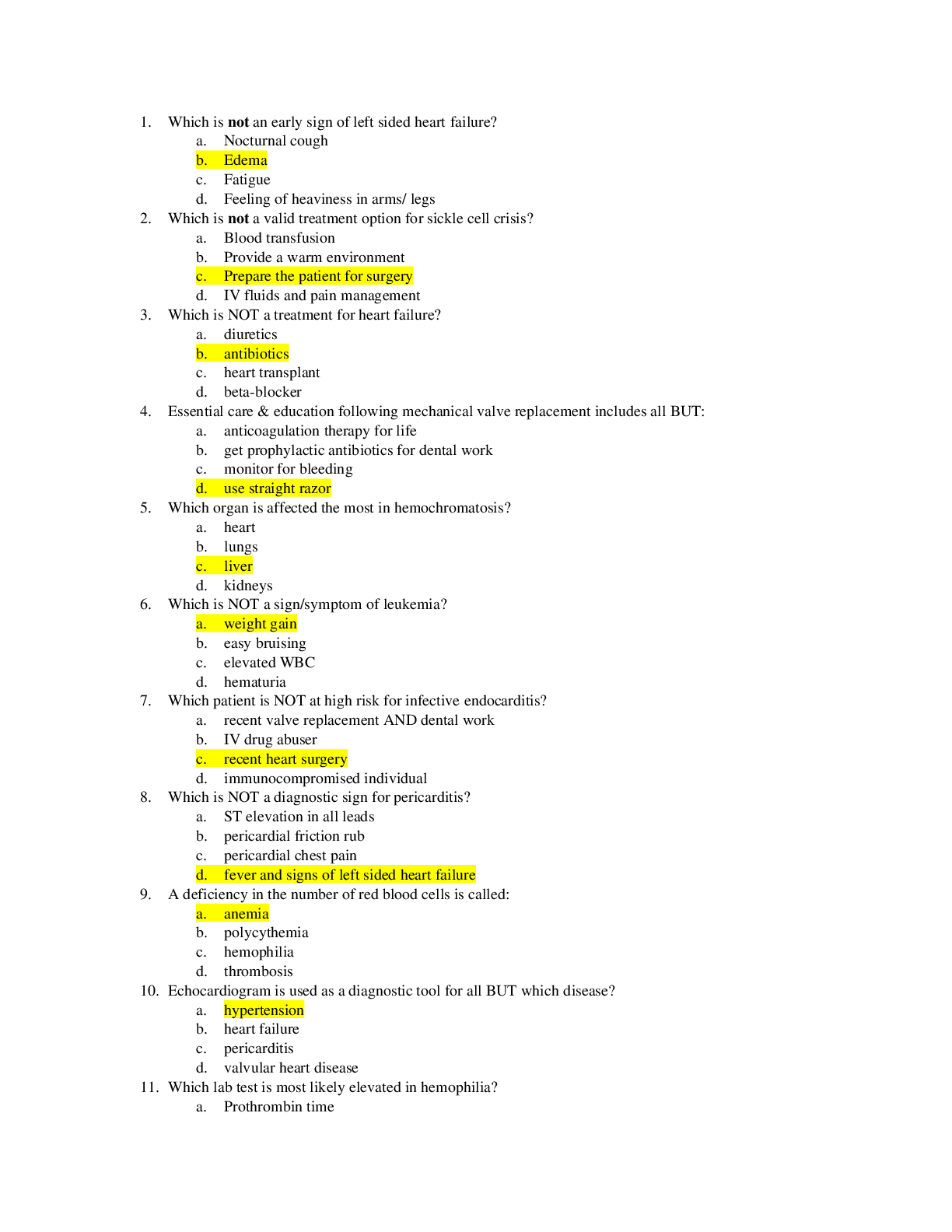
Reviews( 0 )
Document information
Connected school, study & course
About the document
Uploaded On
May 07, 2022
Number of pages
16
Written in
Additional information
This document has been written for:
Uploaded
May 07, 2022
Downloads
0
Views
50




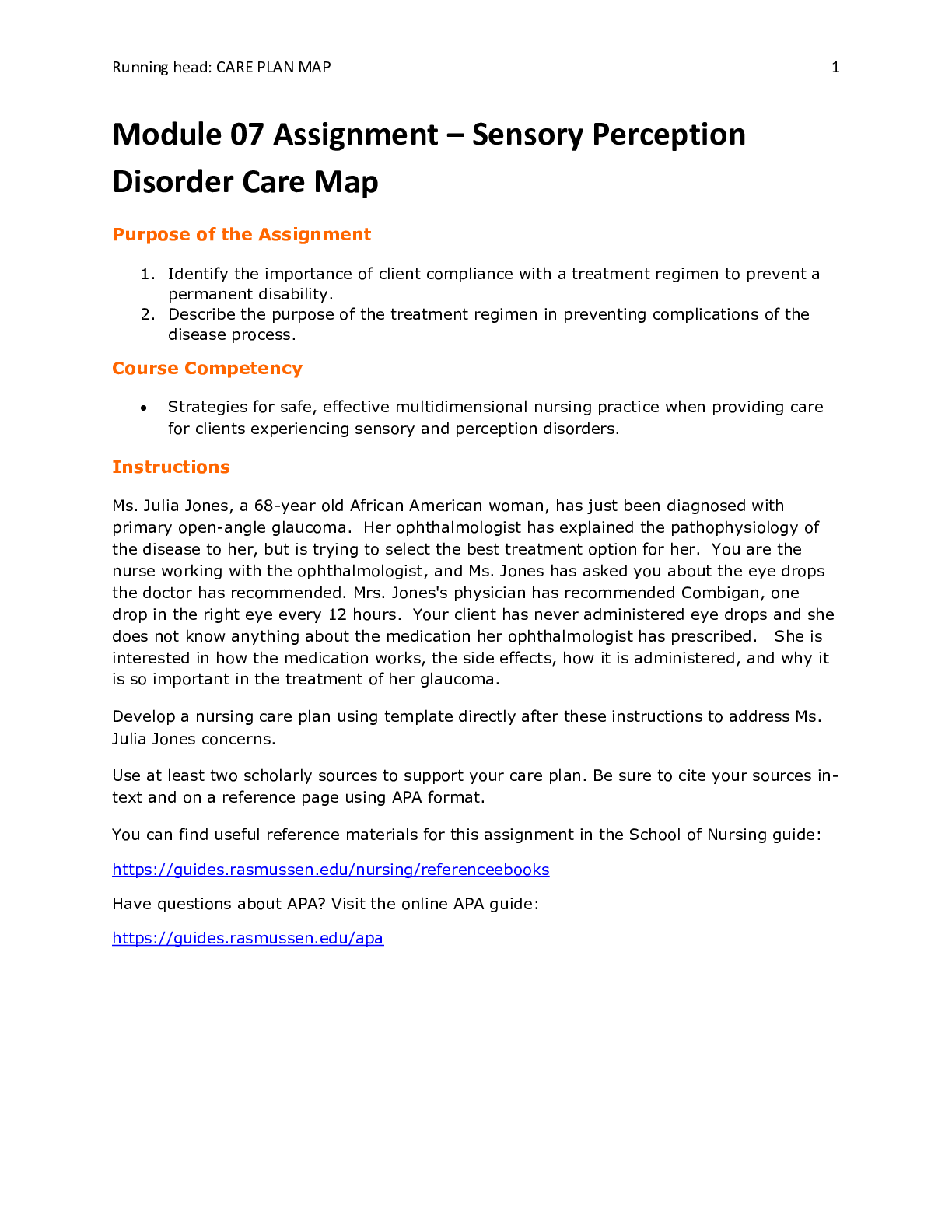
.png)


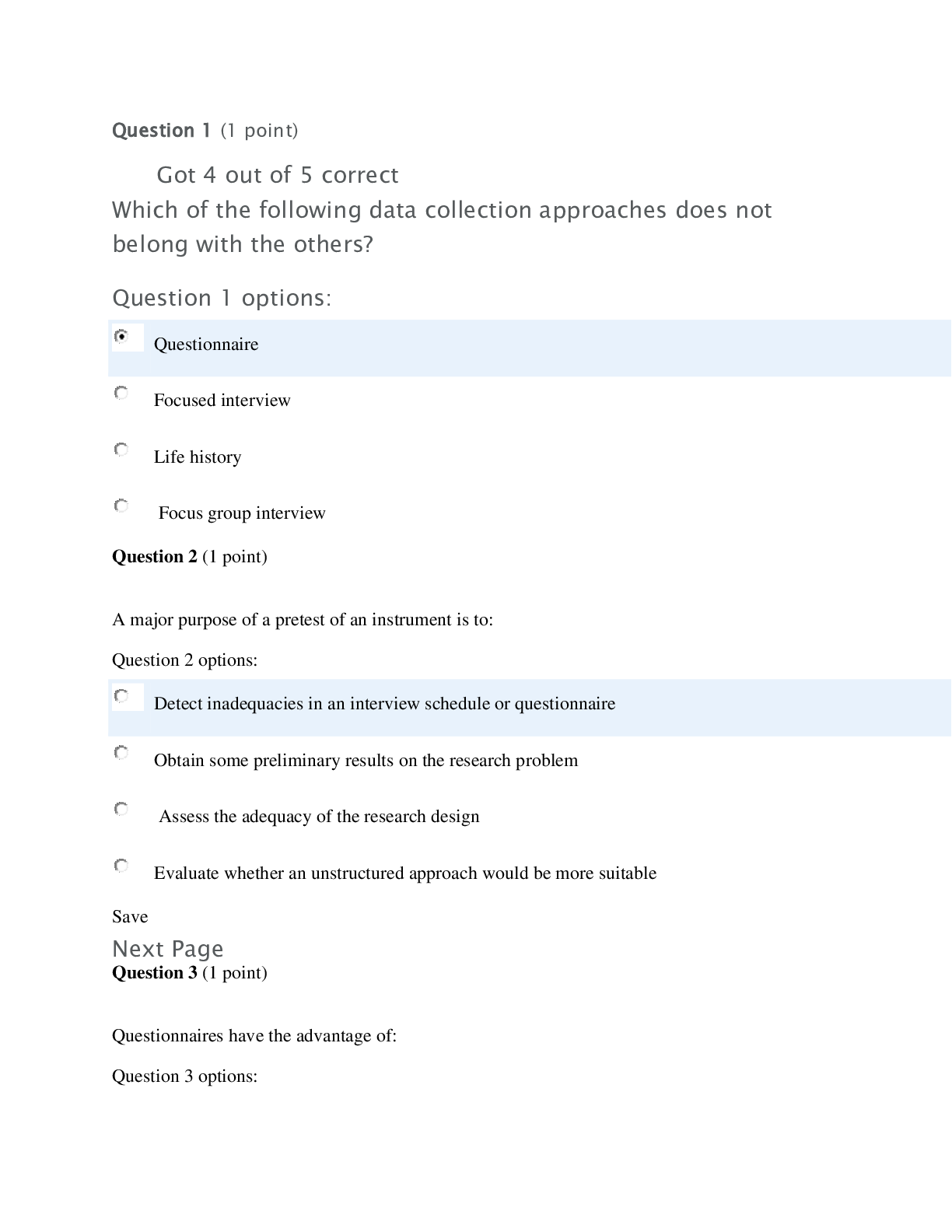


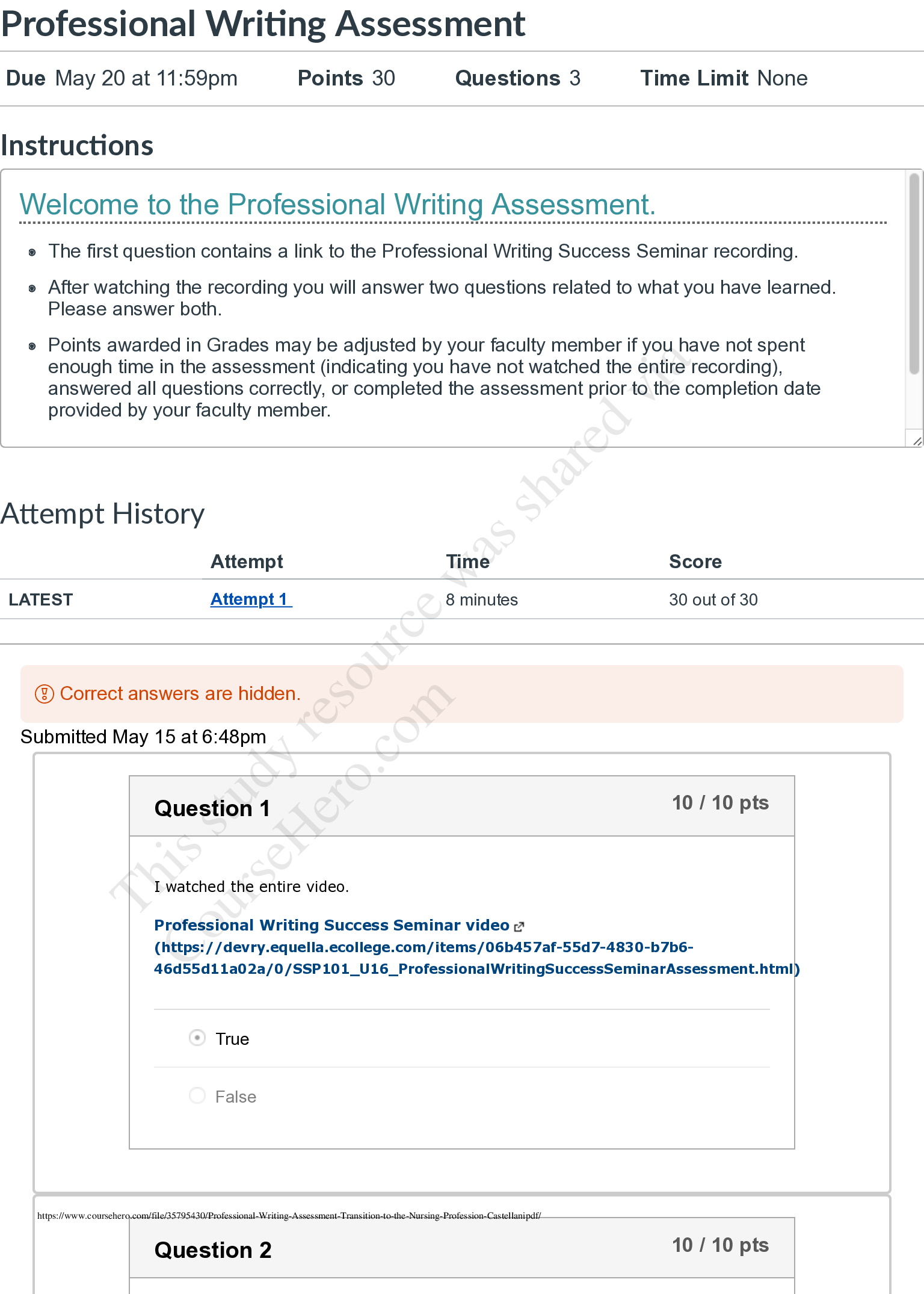
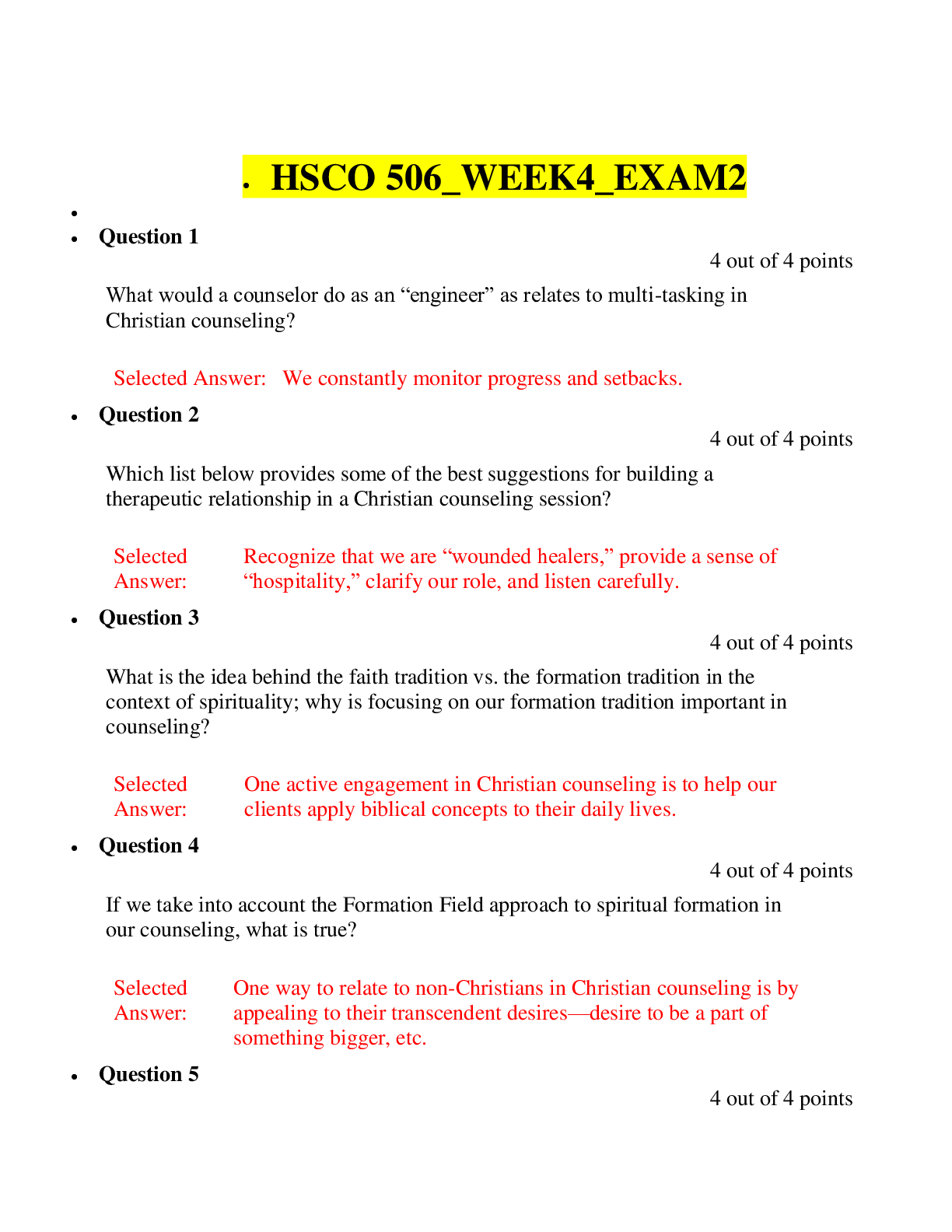
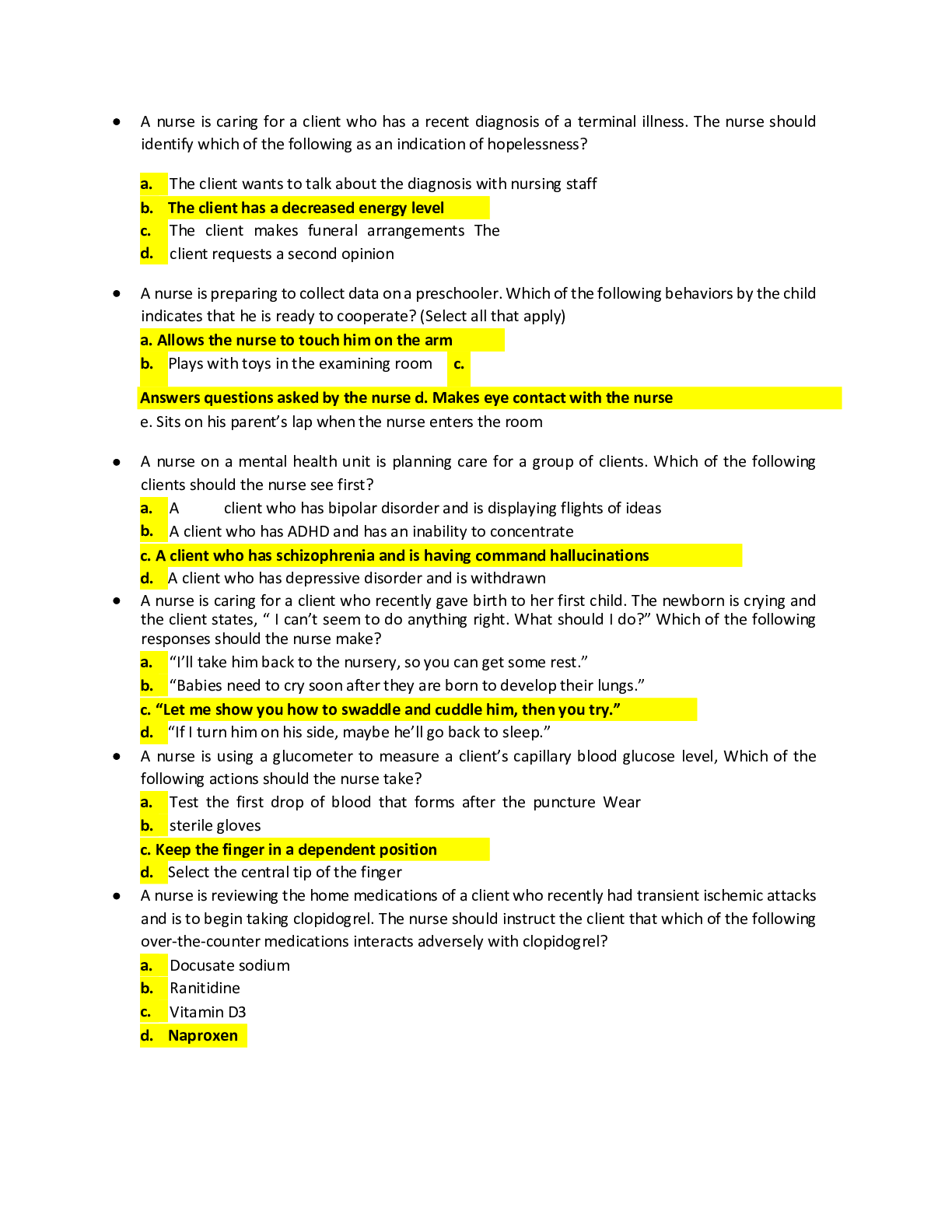
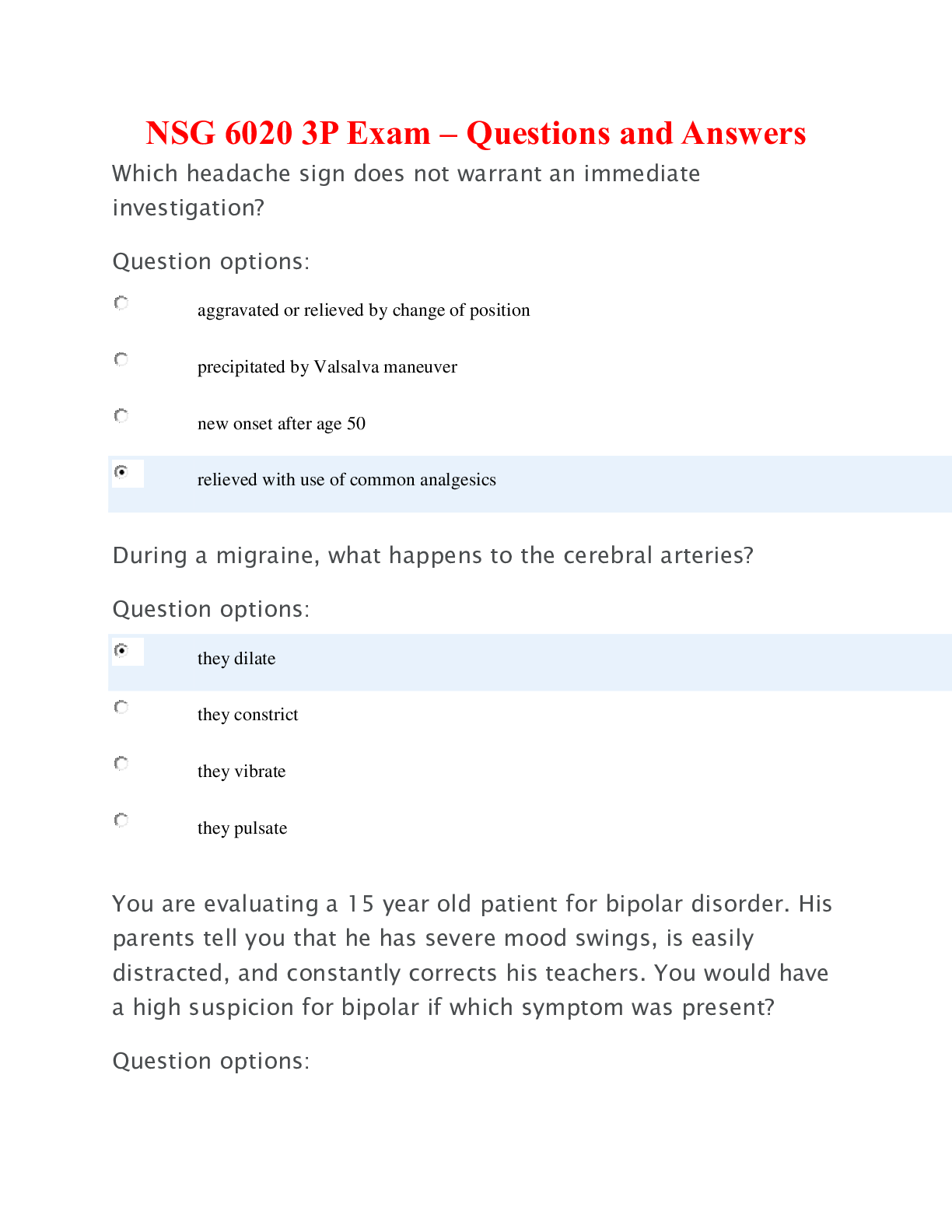
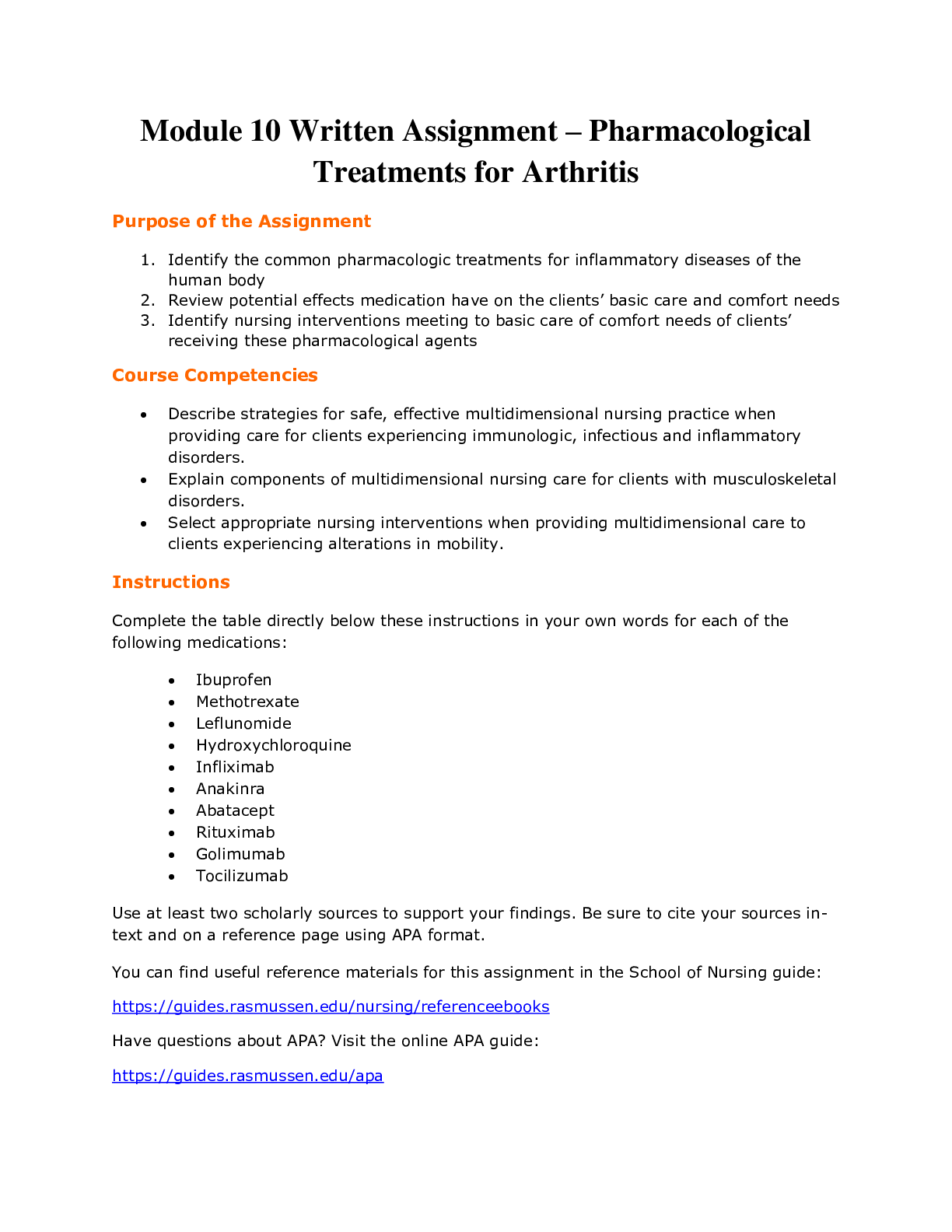
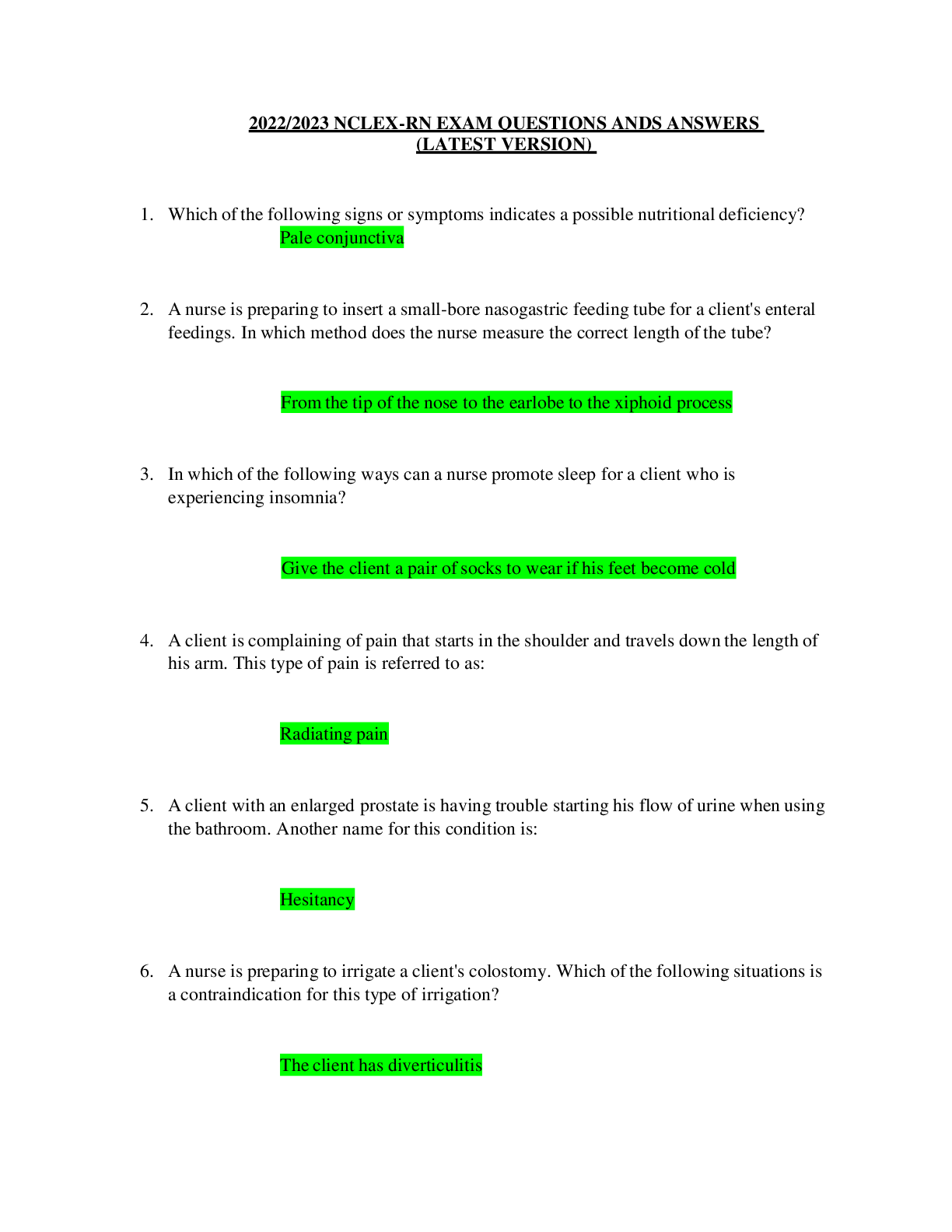

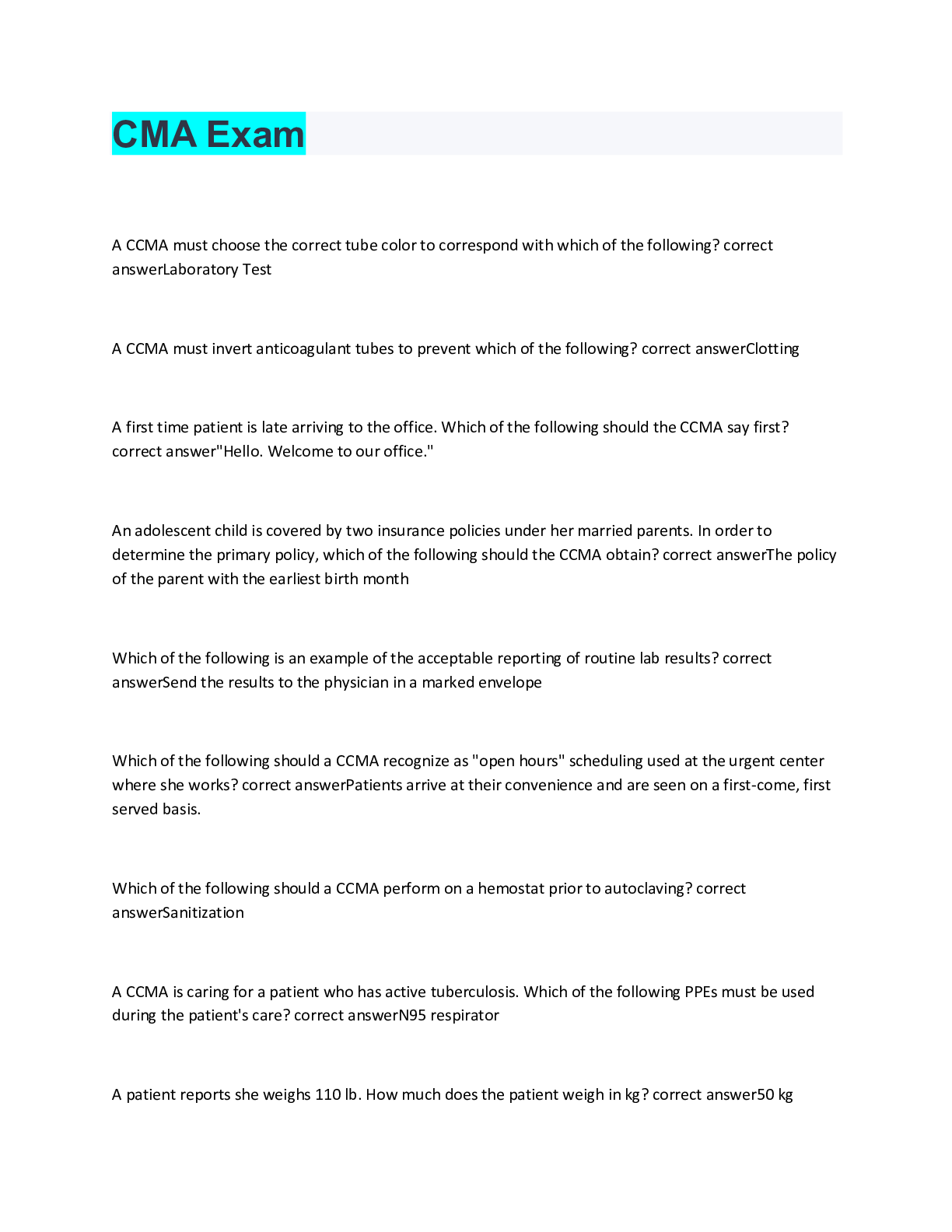
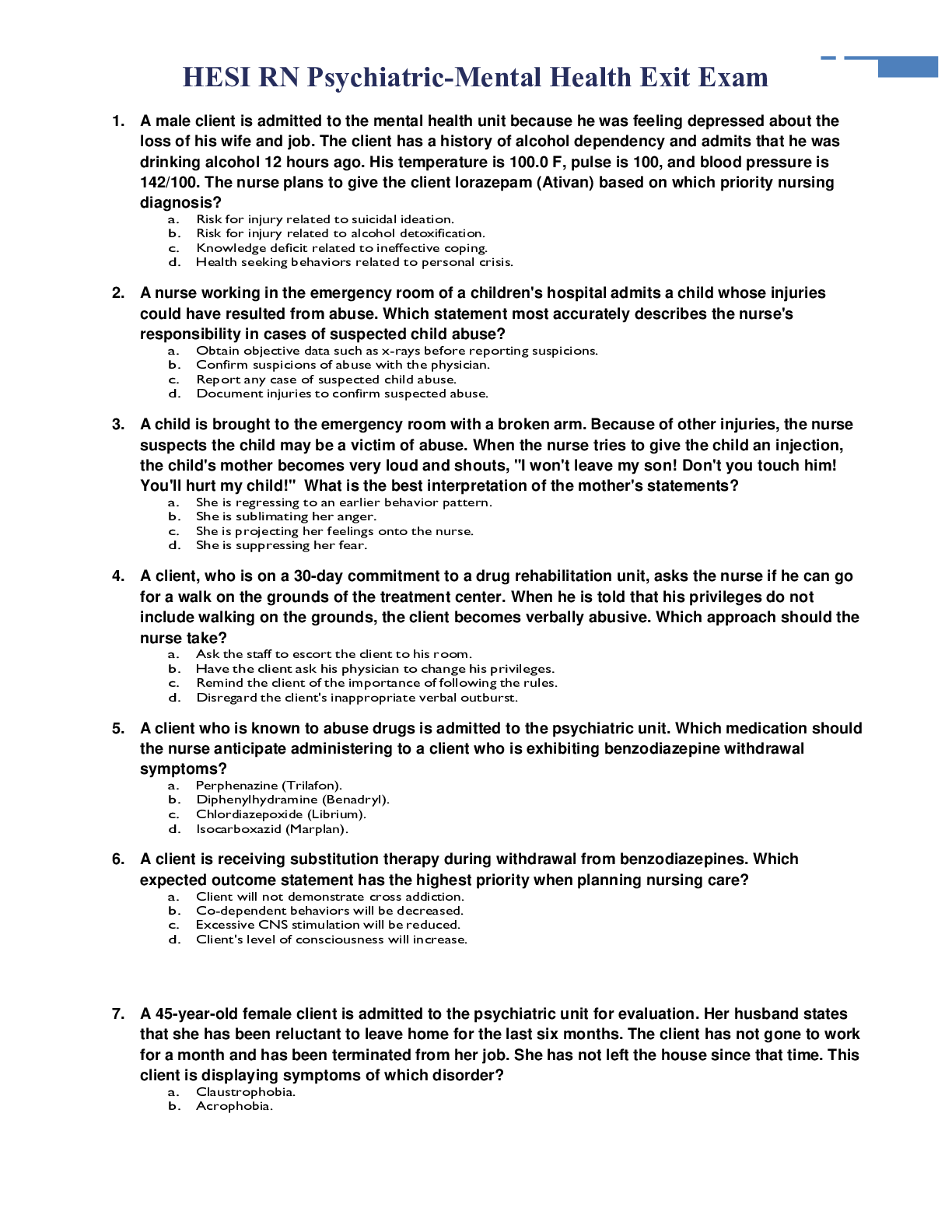
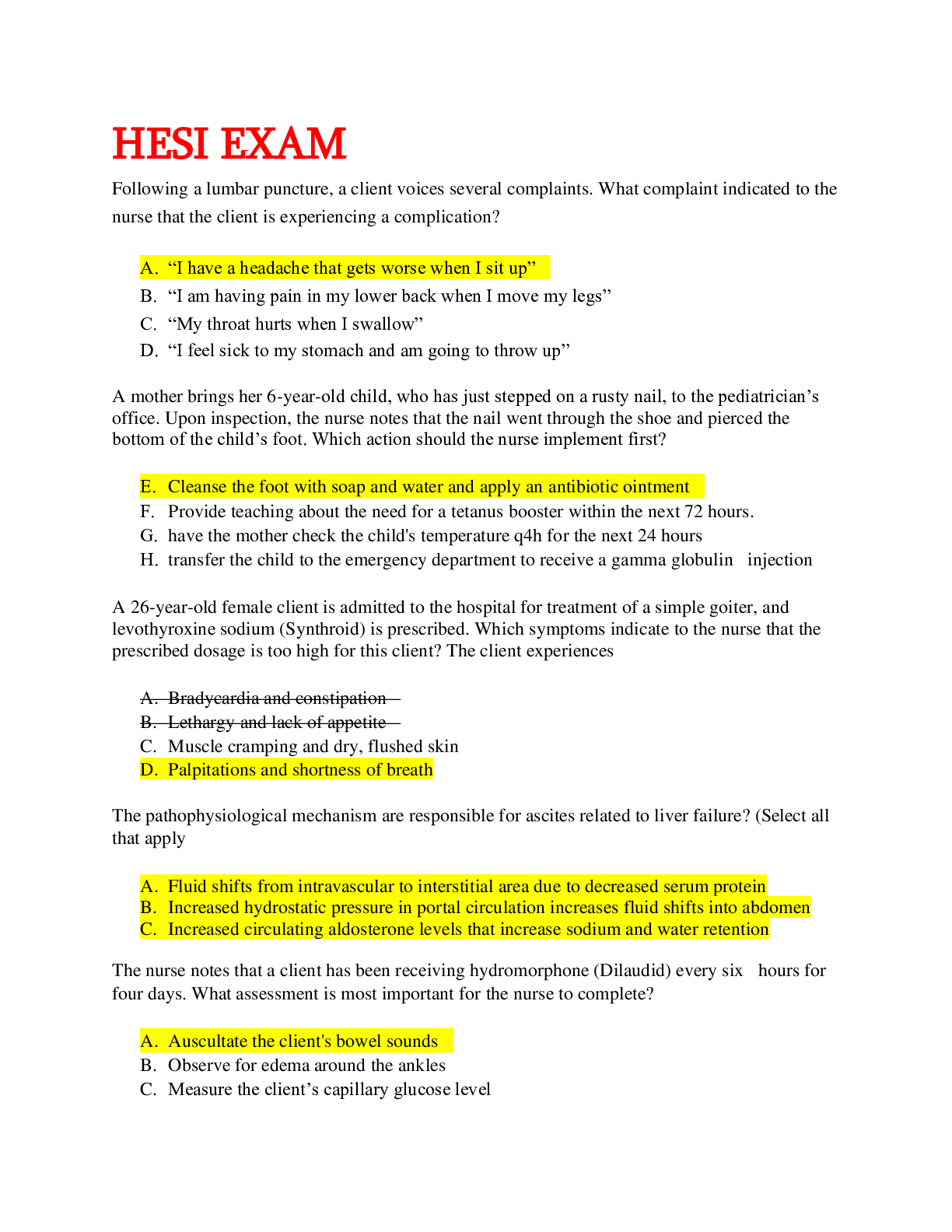
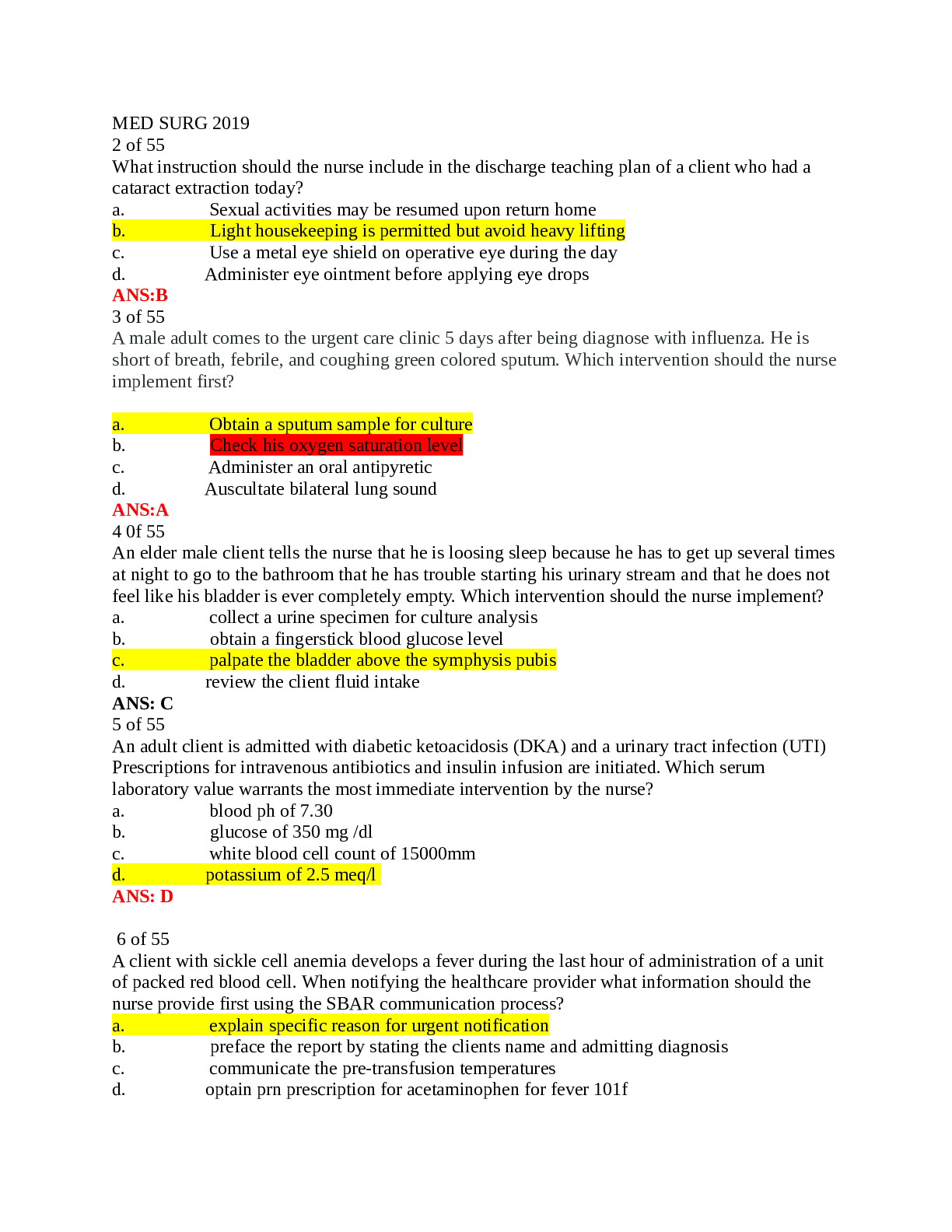

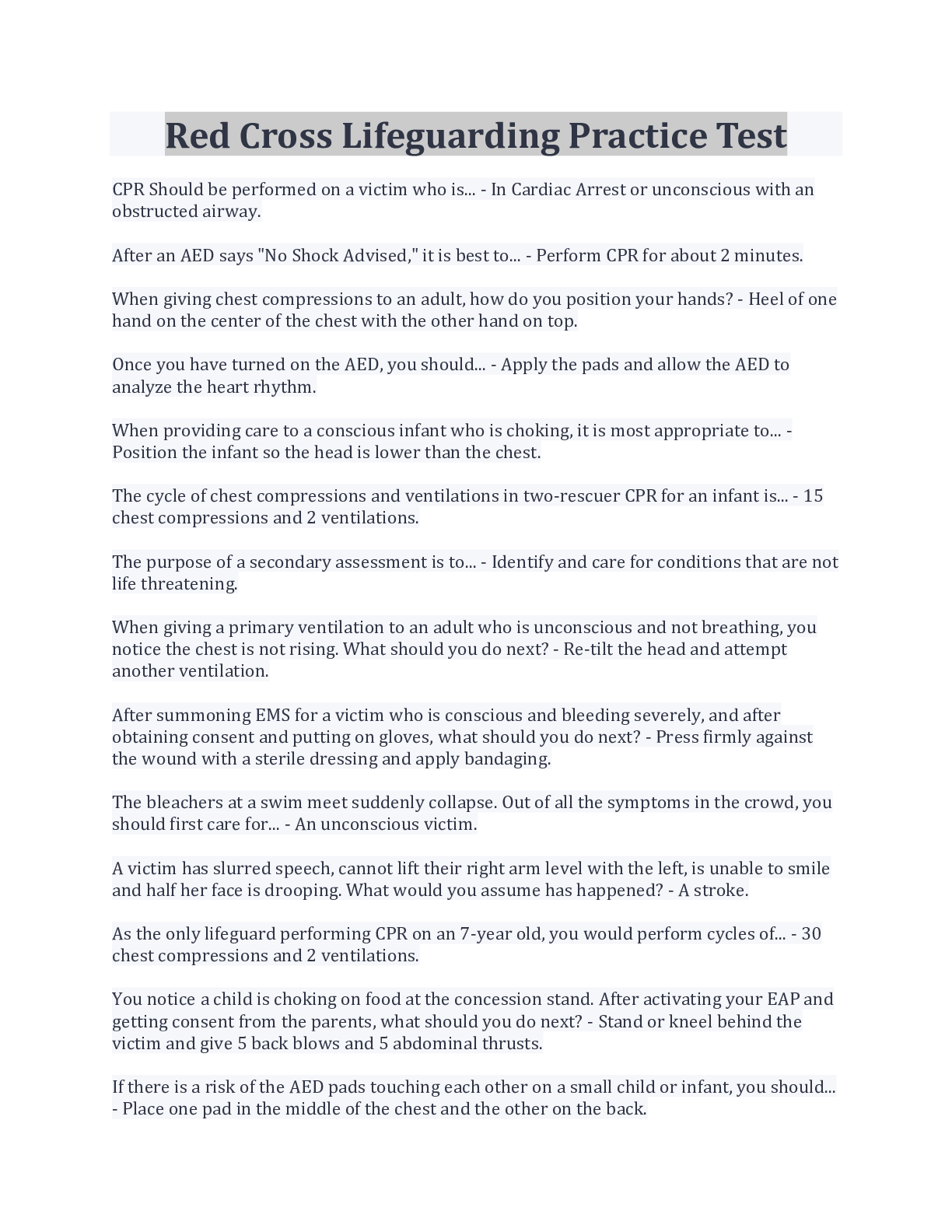

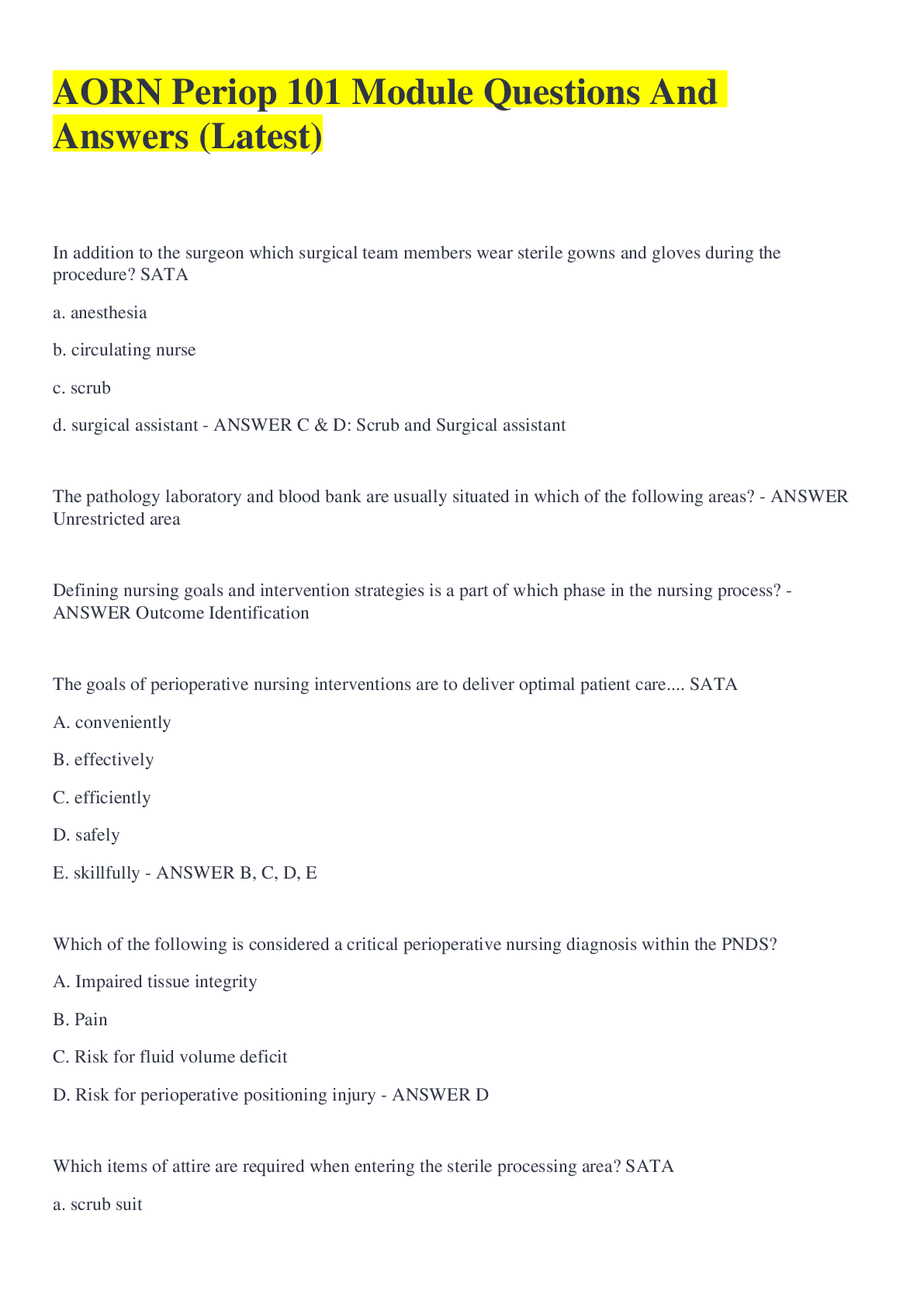
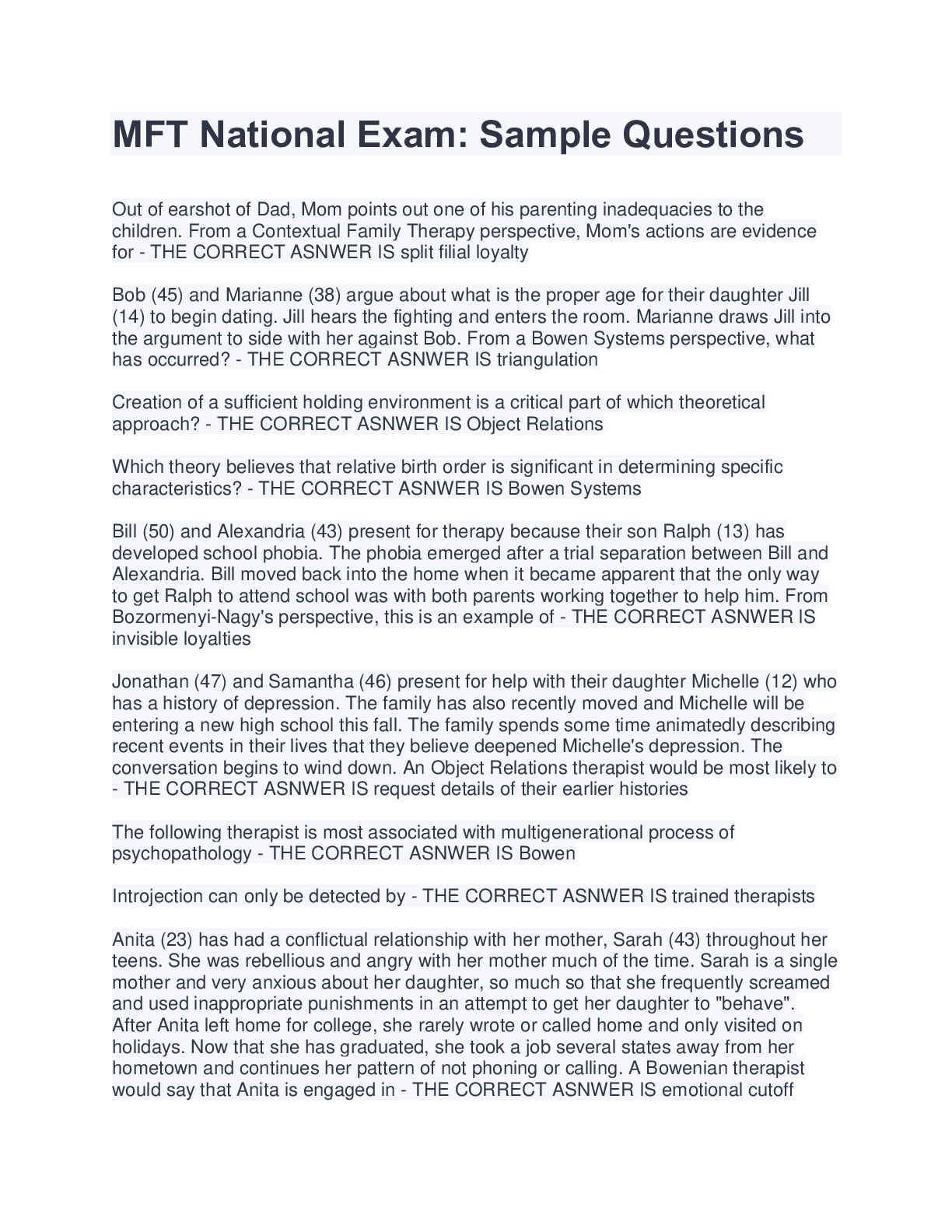

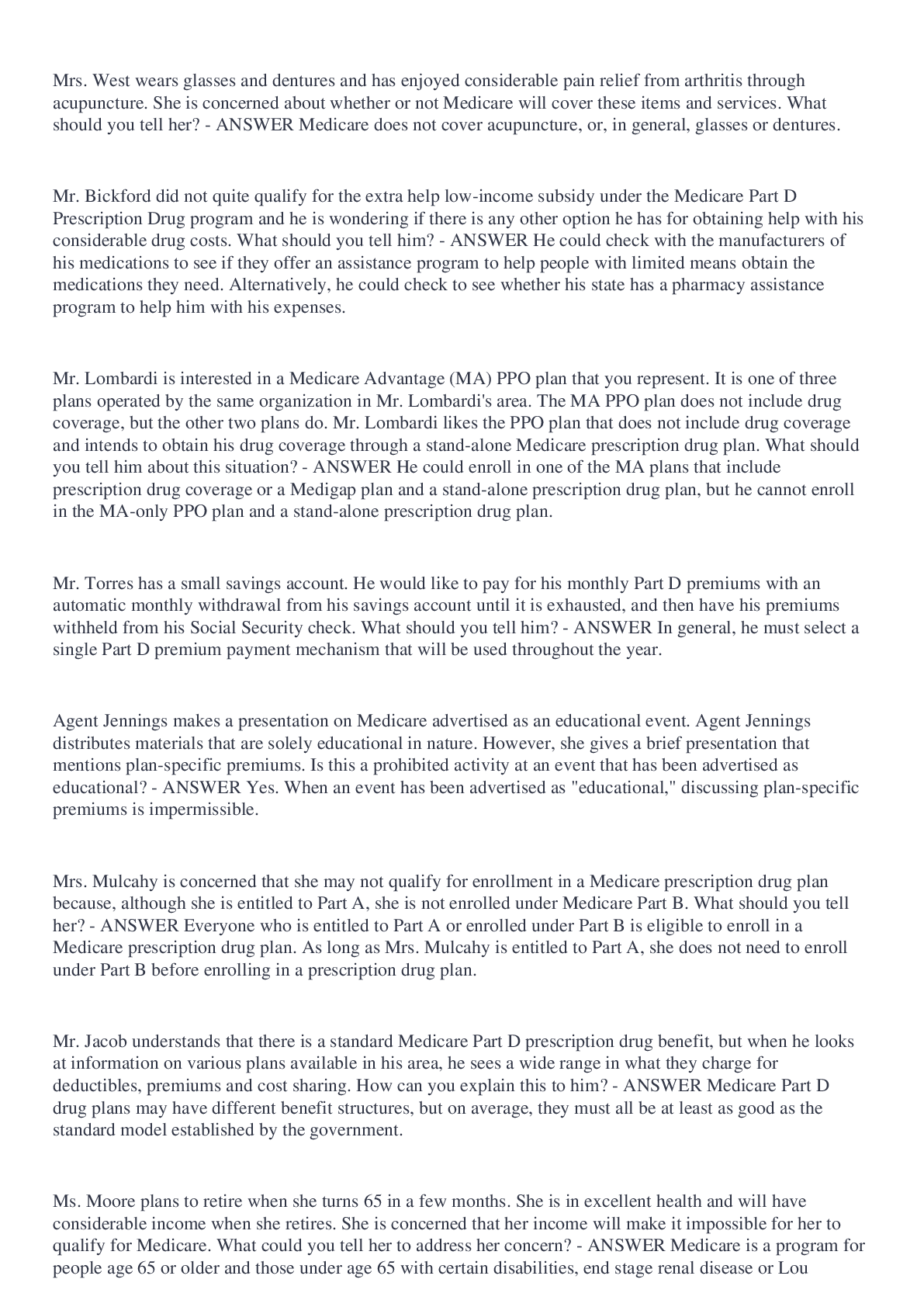
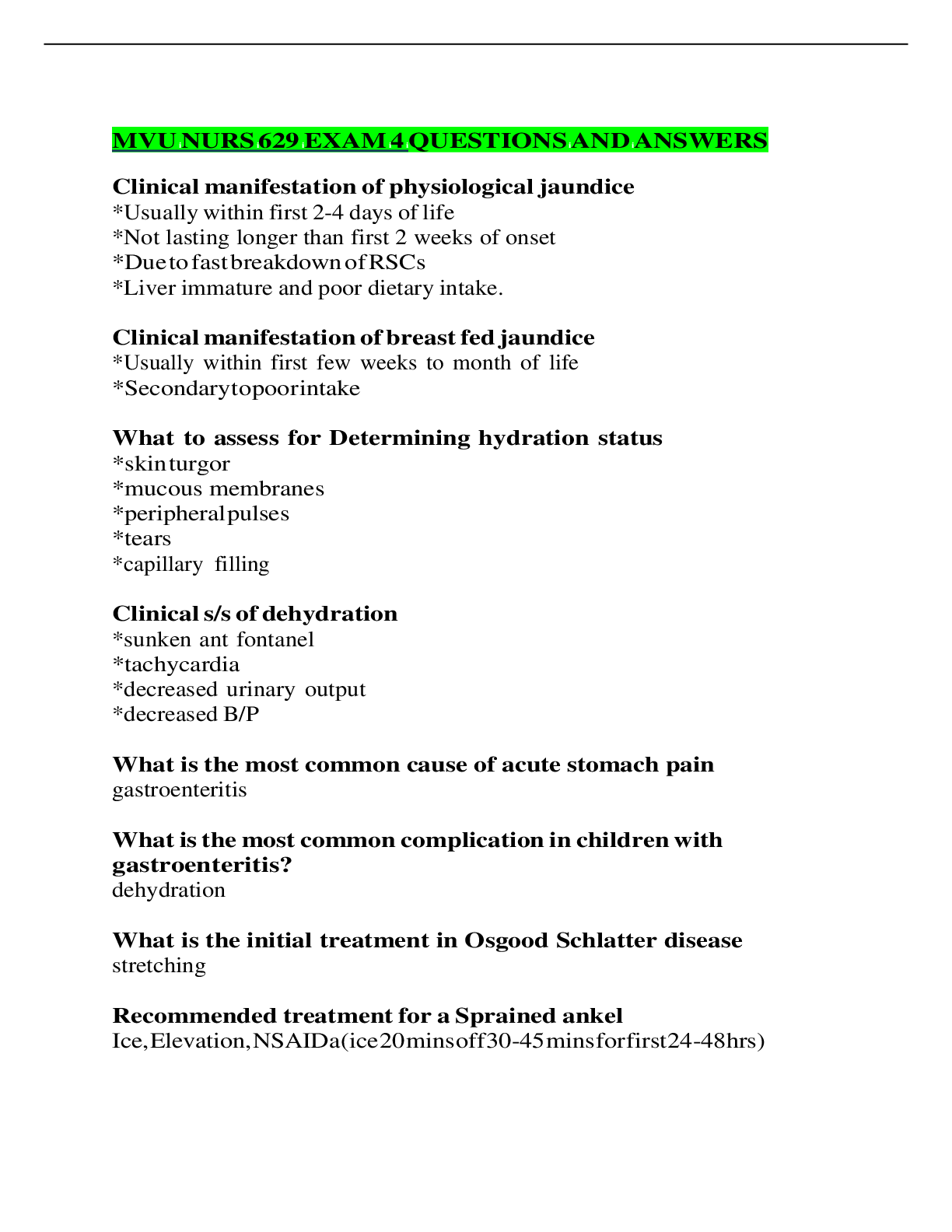
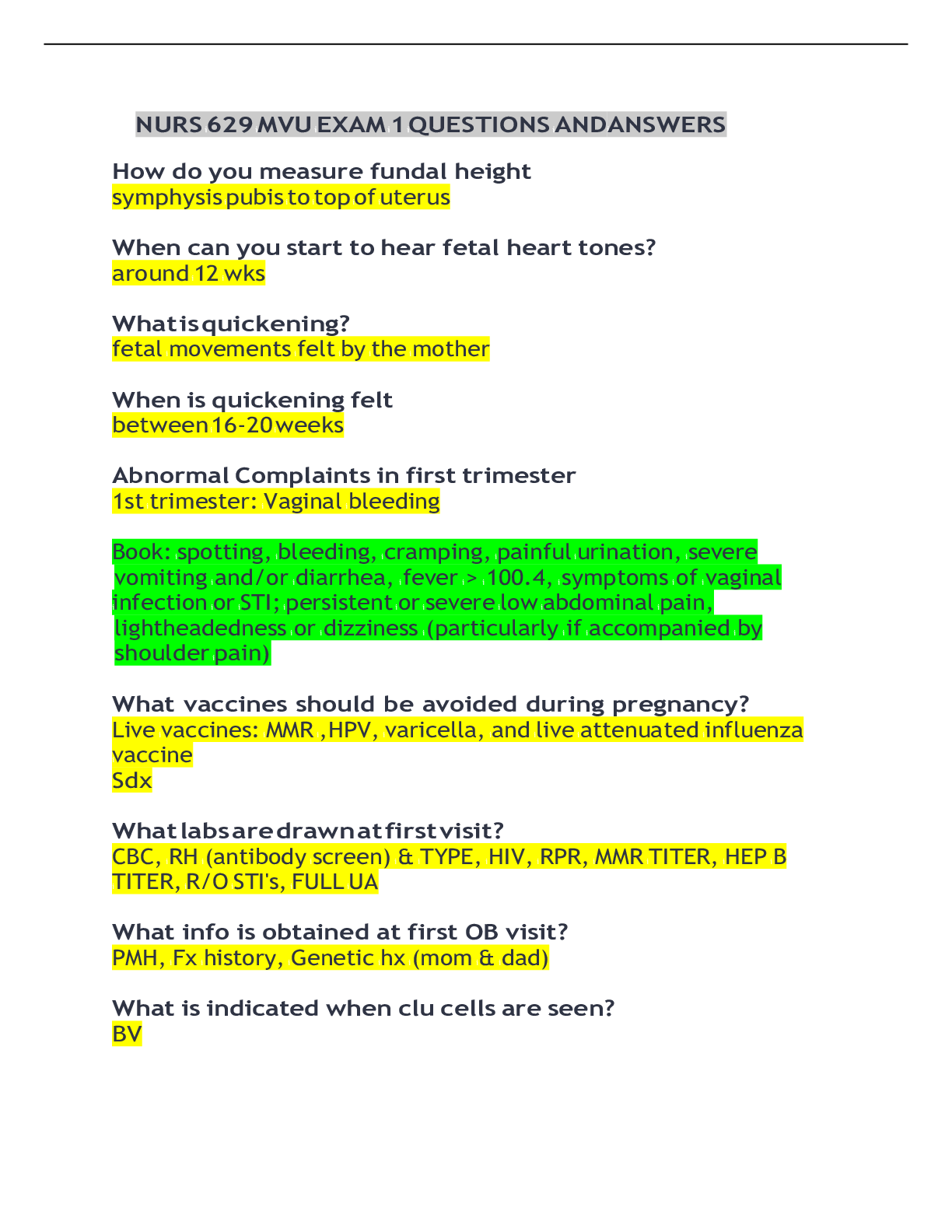


 Verified.png)

